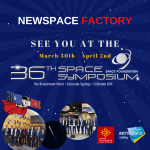NEWSLETTER FEBRUARY, 2020 – Focus on the five firms that helped to develop ANGELS
In recent years, the nanosatellite and cubesat market has seen spectacular growth fuelled by new small-form-factor technologies. Initially driven by universities as a means of providing practical tools to train future engineers and scientists, these developments are today catering for a broad palette of science, technology and commercial missions. In response, CNES and Hemeria decided to join forces in developing a new 12U spacecraft bus called ANGELS.
The goal was to support French industry and spur a new space sector with a modular, effective and low-cost nanosatellite bus in record time. To this end, Hemeria was chosen to design the bus and develop an in-orbit demonstrator along with the ground systems for the test and operations phases. The project got underway in 2017and the demonstrator—dubbed ANGELS, for Argos Neo on a Generic Economical and Light Satellite—is designed to validate the concept in a representative space environment. This demonstrator features a number of systems from the Newspace Factory group: patch antennas from Anywaves, flight and ground software from CS Group, a power conditioning and distribution unit from EREMS and mechanical expertise from Mecano ID.
Anywaves is a spin-off from CNES and the first European start-up to emerge as a pure play antenna supplier for New Space. With its S-band TTC antennas from Anywaves, ANGELS sent its first signal back to Earth and connected the nanosatellite to assure its successful operation for years to come. Anywaves’ ambition is to become the leader in small-form-factor antennas for New Space and critical systems.
For the ANGELS mission, CS Group developed an innovative and economical ground control segment optimized for nanosatellites. Called CS NANO, this product is configurable and reusable for all types of nanosatellites and constellations. CS Group is also contributing its expertise to assist integration and operation of the software on ANGELS.
Electronics firm EREMS has designed and developed in partnership with CNES an innovative radiation-hardened power conditioning and distribution unit. Called PCDU NANO, this product is built around a modular architecture geared towards the needs of nanosatellites in the 6U-to-27U class. EREMS also developed the embedded software based on an innovative algorithm that optimizes distribution of power from solar panels and the battery. The first flight model is on the ANGELS mission.
Hemeria is an SME active in the two critical domains of space and France’s submarine nuclear deterrence. It is playing an active role shaping the future of space, notably through its innovative line of nanosatellites. Work on development through to final assembly of the ANGELS nanosatellite was carried out in Hemeria’s facility in Toulouse by a Hemeria-CNES integrated project team.
Mecano ID was responsible for mechanical and thermal engineering, as well as environmental testing of the satellite on behalf of Hemeria, and for fabrication and environmental testing of the S-band antennas for Anywaves.








